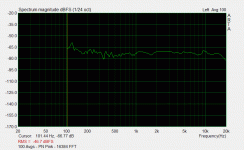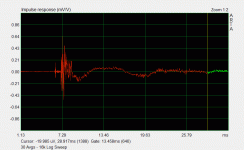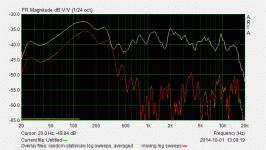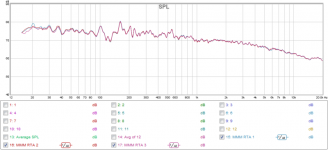Maybe with very short sweeps ? Why not try, I don't think one has to worry about any Doppler distortion due to the movement...If I run HolmImpulse using a log sweep and a moving mic will the resulting impulse response be reasonable?
Doing it with dirac pulses should work but you have no LF energy.
Well, don't you have easier questions to ask ?If a swept Holm does work, then what kind of average would this be? Time as well as space?
Last edited:
jlo
I wish that it were easier for me to setup measurements in my listening room. Unfortunately that room is very busy being the main entertainment complex or the entire family. I have my loudspeaker measurement space, but the acoustics of that room are terrible. Experimenting in my listening room is very difficult because it is full of furniture, and all the equipment is in cabinets and not available from inside of the listening room. I just never envisioned doing "experiments" in this room. It is not setup for that.
I would try your POPs software, but I would like to write my own code for doing that as I am not a pro at MatLab as I am at signal processing in a lower level language. I wrote you an E-mail hoping you could outline what you do in the Matlab code and I would duplicate it in VB.Net and FORTRAN (which creates blazing fast execution times).
I wish that it were easier for me to setup measurements in my listening room. Unfortunately that room is very busy being the main entertainment complex or the entire family. I have my loudspeaker measurement space, but the acoustics of that room are terrible. Experimenting in my listening room is very difficult because it is full of furniture, and all the equipment is in cabinets and not available from inside of the listening room. I just never envisioned doing "experiments" in this room. It is not setup for that.
I would try your POPs software, but I would like to write my own code for doing that as I am not a pro at MatLab as I am at signal processing in a lower level language. I wrote you an E-mail hoping you could outline what you do in the Matlab code and I would duplicate it in VB.Net and FORTRAN (which creates blazing fast execution times).
Maybe I have some time in the next days to do this experiment.I wish that it were easier for me to setup measurements in my listening room.
I'll send you tomorrow my way of doing the LOC calculation based on D.Griesinger's code, but a bit different because he is focused on room acoustics and I tried to adapt it for stereo loudspeakers within a room.I would try your POPs software, but I would like to write my own code for doing that as I am not a pro at MatLab as I am at signal processing in a lower level language. I wrote you an E-mail hoping you could outline what you do in the Matlab code and I would duplicate it in VB.Net and FORTRAN (which creates blazing fast execution times).
The early versions of HOLM had averaging, you could set the number of sweeps. That's gone now (or at least I can't find it). But I don't see how it could work unless you did a high number of sweeps while moving.My question is this. If I run HolmImpulse using a log sweep and a moving mic will the resulting impulse response be reasonable?
Is there a way to calculate the impulse when different parts of the sweep are taken at different positions?
I can give this a try on Friday and post results compared to pink noise REW moving mic.
I wouldn't expect moving mic sweeps to provide any value. I am not clear what the benefit would be for EQ purposes even if it did work. I assume we would still align the measurements for averaging using beam forming; comparatively much more work than MMM. The major benefit to MM is just a quick, easy, repeatable way to provide data for EQ purposes. I still use sweeps for all other purposes.
But... I can relatively easily try it and compare the result and repeatability to the other methods mentioned above if there is interest.
But... I can relatively easily try it and compare the result and repeatability to the other methods mentioned above if there is interest.
I think that the motivation was expressed before. You can't really do any psychoacoustic tailoring of the EQ when you only have steady state data like you can when you have impulse responses. I see that as a very big benefit.
But then I don't understand "I assume we would still align the measurements for averaging using beam forming; "
Beam forming?
But then I don't understand "I assume we would still align the measurements for averaging using beam forming; "
Beam forming?
Sorry, this must be the wrong terminology. It is necessary to align the IR timing when averaging sweeps at different distances. With a moving mic there will still be an initial IR peak indicative of the arrival of the highest freqs. I assume that it would still be used to align the IR sweeps for averaging.
I thought I saw this alignment of signals referred to a beamforming on this site someplace, but this may well be incorrect terminology?
I also must have missed that the moving sweep technique being discussed was intended for another purpose than EQ.
My batting average is not looking very good.
I thought I saw this alignment of signals referred to a beamforming on this site someplace, but this may well be incorrect terminology?
I also must have missed that the moving sweep technique being discussed was intended for another purpose than EQ.
My batting average is not looking very good.
Not so bad. 
It's true that the impulse alignment has a lot to do with the highest frequencies. Would aligning those help the averaging of sine sweeps taken during a MMM?
If an average phase could be found this way, would it be "blurry"? How much smoothng would it need? Will be interesting to find out.
It's true that the impulse alignment has a lot to do with the highest frequencies. Would aligning those help the averaging of sine sweeps taken during a MMM?
If an average phase could be found this way, would it be "blurry"? How much smoothng would it need? Will be interesting to find out.
To get direct sound phase response using sweeps I think it is much better to average various stationary mic locations around the listening position that works pretty well in my experience.
I have the same concern that you mention regarding moving the mic. The MF and HF phase will poorly correlated with strange results. I don't see the savings in moving the mic during a sweep measurement anyway. This is more difficult to do than stationary measurement and we still need to manually do the averages.
I guess you may be envisioning at measurement program that loops repeated sweeps for us. I only use Holm and REW so I don't have one of those. I will try to simulate the result by mic movement during individual sweeps and averaging them together manually and post what I get.
I have the same concern that you mention regarding moving the mic. The MF and HF phase will poorly correlated with strange results. I don't see the savings in moving the mic during a sweep measurement anyway. This is more difficult to do than stationary measurement and we still need to manually do the averages.
I guess you may be envisioning at measurement program that loops repeated sweeps for us. I only use Holm and REW so I don't have one of those. I will try to simulate the result by mic movement during individual sweeps and averaging them together manually and post what I get.
I'm not sure I understand what the different people are pondering over the past few pages here, but these are what happens when I do what I assume is the original suggestion with RTA, and then the mess of an impulse that results when moving the mic around across a bunch of sweeps (averaged automatically without any re-alignment). These are just at the desk, standing to the side and moving the mic around the "listening area", approx. 0.5 m cube.
Attachments
Just a couple of comments...
Impulse responses are going to be very unreliable with moving mic. High frequencies will cancel with small shifts and the curve will be poorly related to the room average. Moving mic is not much different than a multiposition average. Take enough averages and they will converge on the same thing.
When averaging measurements, there are always at least 2 options: a time average or an RMS curve average. Time averaging is only proper if the system is stationary and will lead to the shifted impulse errors mentioned above if we are either moving the mic or averaging multiple positions. You really want to do an energy average or root of the mean of the squares type average. This loses the time element but won't suffer from cancelation.
A lot of FFT units also allow a running average (a never ending exponential decay type average) or an alternative, so-many-samples average (usually called a linear average as each record is averaged equally rather than the exponential weight mentioned. If the FFT lets you specify the number of averages (i.e.32) then that is a linear average and would be the type to use. Set the unit to run and move the mic slowly around the sample area at a rate that lets you complete a loop in the 32 (or whatever qty.) averages.
Averaging is good if you want to EQ across a seating area. You will loose sight of some issues, such as diffraction/reflection effects (not necessarily good) and room standing waves (probably good). Note that the larger the area you average over the more likely a specific spot in that area deviates from the average. That is, the EQ will suit the area average but will be less good for any particular point in it.
You pays your money and you takes your choice.
David
Impulse responses are going to be very unreliable with moving mic. High frequencies will cancel with small shifts and the curve will be poorly related to the room average. Moving mic is not much different than a multiposition average. Take enough averages and they will converge on the same thing.
When averaging measurements, there are always at least 2 options: a time average or an RMS curve average. Time averaging is only proper if the system is stationary and will lead to the shifted impulse errors mentioned above if we are either moving the mic or averaging multiple positions. You really want to do an energy average or root of the mean of the squares type average. This loses the time element but won't suffer from cancelation.
A lot of FFT units also allow a running average (a never ending exponential decay type average) or an alternative, so-many-samples average (usually called a linear average as each record is averaged equally rather than the exponential weight mentioned. If the FFT lets you specify the number of averages (i.e.32) then that is a linear average and would be the type to use. Set the unit to run and move the mic slowly around the sample area at a rate that lets you complete a loop in the 32 (or whatever qty.) averages.
Averaging is good if you want to EQ across a seating area. You will loose sight of some issues, such as diffraction/reflection effects (not necessarily good) and room standing waves (probably good). Note that the larger the area you average over the more likely a specific spot in that area deviates from the average. That is, the EQ will suit the area average but will be less good for any particular point in it.
You pays your money and you takes your choice.
David
I'm not sure I understand what the different people are pondering over the past few pages here, but these are what happens when I do what I assume is the original suggestion with RTA, and then the mess of an impulse that results when moving the mic around across a bunch of sweeps (averaged automatically without any re-alignment). These are just at the desk, standing to the side and moving the mic around the "listening area", approx. 0.5 m cube.
Not unexpected, but not entirely unreasonable or unusable. Its not like what comes back is total garbage - it gives you something. The question to me is what you get the same frequency response that you would get if you average several stationary locations? If it is then I am very intrigued, because one could do some interesting things with that result.
I completed my measurements also. They agree with yours, and what I think we all expected. The IR and the phase and SR are badly distorted when moving the mic (MMM) using sweeps. The SPL is fine however. Averages coming soon.
12 IRs using MMM with Sweeps:
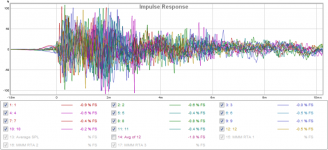
12 Phase using MMM with Sweeps:
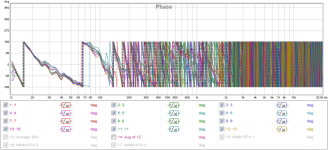
12 SPLs using MMM with Sweeps:
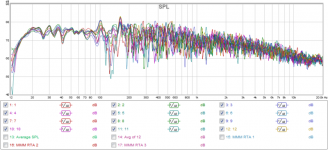
The 12 SPL (1/48th octave) charts are similar to the results with different mic positions in the same range.
12 IRs using MMM with Sweeps:

12 Phase using MMM with Sweeps:

12 SPLs using MMM with Sweeps:

The 12 SPL (1/48th octave) charts are similar to the results with different mic positions in the same range.
Certainly not just doing it the way I did, no:The question to me is what you get the same frequency response that you would get if you average several stationary locations? If it is then I am very intrigued, because one could do some interesting things with that result.
Attachments
SPL comparison for different averaging methods.
3 methods agree closely:
> Simple SPL average of 12 sweeps using stationary mic positions (green)
> MMM of 12 sweeps (blue).
> MMM using RTA “forever” averaging (magenta).
1 method does not follow the others:
> Aligning IRs of 12 sweeps using stationary mic positions averaging the IRs (red)
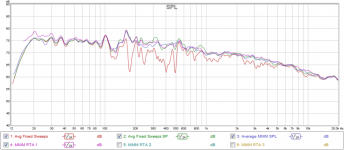
The MMM RTA is quick, easy and repeatable compared to the others.
The 3 SPL traces that agree above also relate well to close mic measurements. Below is MMM vs 24” measurement sweep w/SWs off.
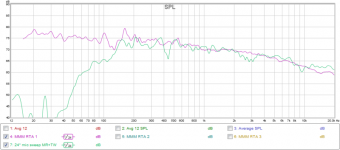
3 methods agree closely:
> Simple SPL average of 12 sweeps using stationary mic positions (green)
> MMM of 12 sweeps (blue).
> MMM using RTA “forever” averaging (magenta).
1 method does not follow the others:
> Aligning IRs of 12 sweeps using stationary mic positions averaging the IRs (red)

The MMM RTA is quick, easy and repeatable compared to the others.
The 3 SPL traces that agree above also relate well to close mic measurements. Below is MMM vs 24” measurement sweep w/SWs off.

I also did some comparisons :
Blue is MMM with pink noise
Red is moving mic with sweeps (16 sweeps of 1s with 1 s silence in between)
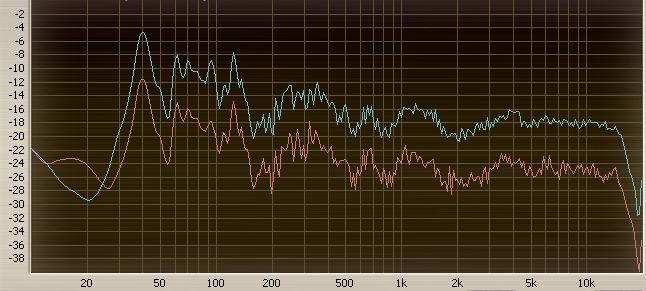
As expected, average rms is very similar.
But for now, my impulse responses calculated from moving mic measurements cannot be used : it is a bit complicated because I did it with the sequence of 16 sweeps and the calculation of the 16 impulses on the same file is not so easy
It was worth trying with moving sweeps because with one measurement you would get the amplitude but also the phase...
Maybe a much shorter signal than sweeps could give something.
Blue is MMM with pink noise
Red is moving mic with sweeps (16 sweeps of 1s with 1 s silence in between)

As expected, average rms is very similar.
But for now, my impulse responses calculated from moving mic measurements cannot be used : it is a bit complicated because I did it with the sequence of 16 sweeps and the calculation of the 16 impulses on the same file is not so easy
It was worth trying with moving sweeps because with one measurement you would get the amplitude but also the phase...
Maybe a much shorter signal than sweeps could give something.
This was the main point of the topic, it's nice that we come to same conclusion.The MMM RTA is quick, easy and repeatable compared to the others.
Last edited:
Maybe the main advantage of spatial averaging near listening place is that it averages out more the reflections and less the direct field, loudspeaker diffraction, near walls gain,...Averaging is good if you want to EQ across a seating area. You will loose sight of some issues, such as diffraction/reflection effects (not necessarily good) and room standing waves (probably good). Note that the larger the area you average over the more likely a specific spot in that area deviates from the average. That is, the EQ will suit the area average but will be less good for any particular point in it.
And it seems to me that it corresponds quite closely to what we hear.
As written in my note, this method is the best I found to EQ louspeakers so you get the same timbre from left or right speaker (or center).
I don't think that a very precise EQ at only one particular point (ie a very precise digital room correction with FIR/IIR filters) is such a good solution.
We all have read the Sean Olive paper comparing EQ done with some processors, now a listening comparison of EQ methods would be very interesting, but it is very time consuming to do it properly.
Last edited:
- Status
- This old topic is closed. If you want to reopen this topic, contact a moderator using the "Report Post" button.
- Home
- Loudspeakers
- Multi-Way
- Moving Mic Measurement
